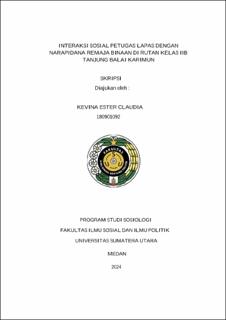| dc.contributor.advisor | Munthe, Hadriana Marhaeni | |
| dc.contributor.author | Claudia, Kevina Ester | |
| dc.date.accessioned | 2024-12-03T04:25:10Z | |
| dc.date.available | 2024-12-03T04:25:10Z | |
| dc.date.issued | 2024 | |
| dc.identifier.uri | https://repositori.usu.ac.id/handle/123456789/99083 | |
| dc.description.abstract | Prisons as a place that often brings together prison officers and prisoners make the establishment of relationships both formally and informally. News about prisons and violence is more often heard than the success of coaching and the well-established interaction between prison officers and prisoners. Forms of violence are carried out by hitting, kicking, and whipping using a hose. This research examines social interactions seen from the front stage and back stage of prison officers and juvenile inmates at the Class II B Tanjung Balai Karimun Detention Center. The main objective of this research is to find out how the social interactions of prison officers and juvenile inmates are seen from the front stage and back stage and to find out the impression management that juvenile inmates build for the first time when they are sentenced to detention in the detention center. This research uses descriptive qualitative methods by conducting interviews and analyzing the social interactions carried out by the seven informants. This research uses Goffman's theory of social interaction and dramaturgy. In this study, the social interactions carried out by the seven informants provide different front and back stages. The results of this study show a harmonious, orderly and organized front stage. On the contrary, it is less humane, fights and additional money that become the backstage setting as a dynamic drama performance between prisoners and prison officers. The strategy pattern of building a good impression is expected to achieve the goal of juvenile prisoners in getting remission or a reduction in prison time. Informants try to give a good appearance or response to be well received by anyone who sees, especially to prison officers. The informants take an attitude that is willing to help if needed to clean the pool, lift goods, and so on. | en_US |
| dc.language.iso | id | en_US |
| dc.publisher | Universitas Sumatera Utara | en_US |
| dc.subject | Social Interaction | en_US |
| dc.subject | Juvenile Prisoners | en_US |
| dc.subject | Prison Officers | en_US |
| dc.subject | Dramaturgy Theory | en_US |
| dc.title | Interaksi Sosial Petugas Lapas dengan Narapidana Remaja Binaan di Rutan Kelas IIB Tanjung Balai Karimun | en_US |
| dc.title.alternative | Social Interaction between Prison Officers and Prisoners Assited Youth in Class IIB Tanjung Balai Karimun Detention Center | en_US |
| dc.type | Thesis | en_US |
| dc.identifier.nim | NIM180901092 | |
| dc.identifier.nidn | NIDN0026056308 | |
| dc.identifier.kodeprodi | KODEPRODI69201#Sosiologi | |
| dc.description.pages | 165 Pages | en_US |
| dc.description.type | Skripsi Sarjana | en_US |
| dc.subject.sdgs | SDGs 10. Reduce Inequalities | en_US |


